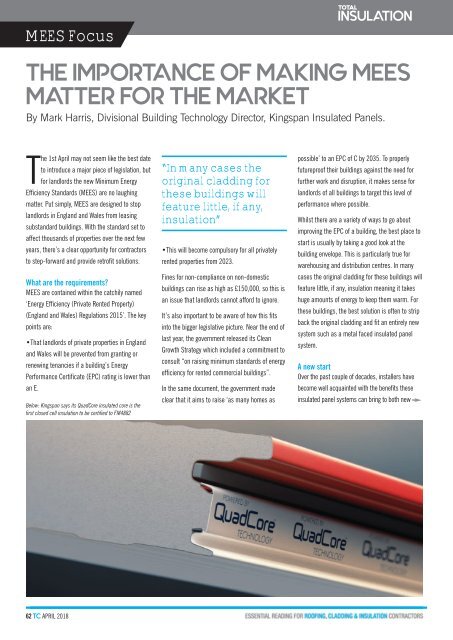April 2018
You also want an ePaper? Increase the reach of your titles
YUMPU automatically turns print PDFs into web optimized ePapers that Google loves.
MEES Focus<br />
THE IMPORTANCE OF MAKING MEES<br />
MATTER FOR THE MARKET<br />
By Mark Harris, Divisional Building Technology Director, Kingspan Insulated Panels.<br />
The 1st <strong>April</strong> may not seem like the best date<br />
to introduce a major piece of legislation, but<br />
for landlords the new Minimum Energy<br />
Efficiency Standards (MEES) are no laughing<br />
matter. Put simply, MEES are designed to stop<br />
landlords in England and Wales from leasing<br />
substandard buildings. With the standard set to<br />
affect thousands of properties over the next few<br />
years, there’s a clear opportunity for contractors<br />
to step-forward and provide retrofit solutions.<br />
What are the requirements?<br />
MEES are contained within the catchily named<br />
‘Energy Efficiency (Private Rented Property)<br />
(England and Wales) Regulations 2015’. The key<br />
points are:<br />
•That landlords of private properties in England<br />
and Wales will be prevented from granting or<br />
renewing tenancies if a building’s Energy<br />
Performance Certificate (EPC) rating is lower than<br />
an E.<br />
Below: Kingspan says its QuadCore insulated core is the<br />
first closed cell insulation to be certified to FM4882<br />
“In many cases the<br />
original cladding for<br />
these buildings will<br />
feature little, if any,<br />
insulation”<br />
•This will become compulsory for all privately<br />
rented properties from 2023.<br />
Fines for non-compliance on non-domestic<br />
buildings can rise as high as £150,000, so this is<br />
an issue that landlords cannot afford to ignore.<br />
It’s also important to be aware of how this fits<br />
into the bigger legislative picture. Near the end of<br />
last year, the government released its Clean<br />
Growth Strategy which included a commitment to<br />
consult “on raising minimum standards of energy<br />
efficiency for rented commercial buildings”.<br />
In the same document, the government made<br />
clear that it aims to raise ‘as many homes as<br />
possible’ to an EPC of C by 2035. To properly<br />
futureproof their buildings against the need for<br />
further work and disruption, it makes sense for<br />
landlords of all buildings to target this level of<br />
performance where possible.<br />
Whilst there are a variety of ways to go about<br />
improving the EPC of a building, the best place to<br />
start is usually by taking a good look at the<br />
building envelope. This is particularly true for<br />
warehousing and distribution centres. In many<br />
cases the original cladding for these buildings will<br />
feature little, if any, insulation meaning it takes<br />
huge amounts of energy to keep them warm. For<br />
these buildings, the best solution is often to strip<br />
back the original cladding and fit an entirely new<br />
system such as a metal faced insulated panel<br />
system.<br />
A new start<br />
Over the past couple of decades, installers have<br />
become well acquainted with the benefits these<br />
insulated panel systems can bring to both new<br />
62 TC APRIL <strong>2018</strong>

















